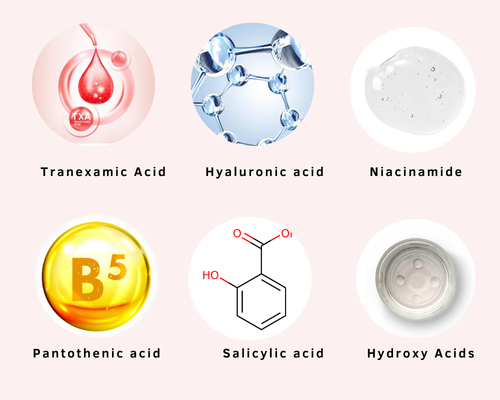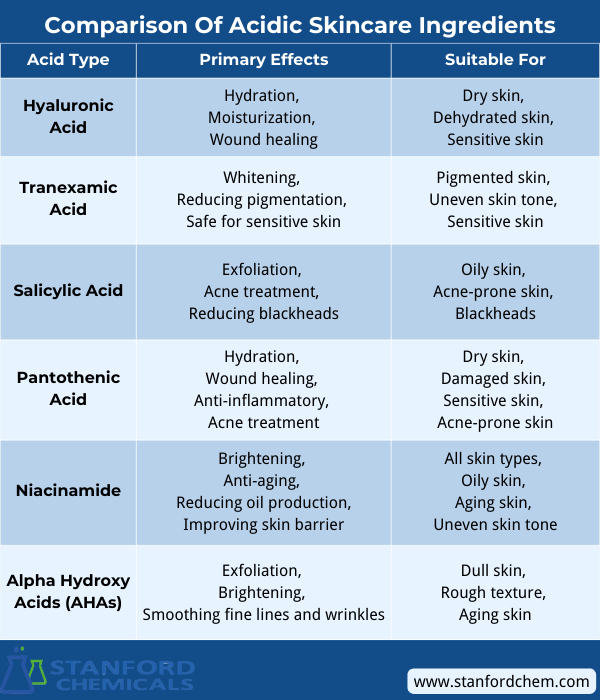Acids in Skincare: What Are the Different Uses and Precautions
Introduction
In skincare, acidic ingredients play a significant role, offering benefits such as whitening, pore reduction, hydration, and wrinkle reduction. Common acids in the skincare industry include alpha hydroxy acids (AHAs), salicylic acid, hyaluronic acid, and tranexamic acid, each serving different purposes. Skincare enthusiasts should choose acids based on their specific skin concerns rather than following trends blindly.
Fig 1. Acidic ingredients in skincare
The Differences Among Acids in Skincare Products
–Hyaluronic Acid
Hyaluronic acid is a natural component widely used in beauty products as a natural moisturizing factor. It is an acidic polysaccharide with a multi-functional matrix, present in every part of the body. Hyaluronic acid forms a three-dimensional honeycomb structure that easily stores moisture. And it has a strong water-absorbing capacity and excellent hydrating effects.
Hyaluronic acid comes in various molecular weights: small, medium, and large. The hydrating effects vary with the molecular weight. When it comes to different molecular weight, please refer to this article for details: Comparative Analysis of Hyaluronic Acid with Different Molecular Weights. Besides hydration, it is also used for filling and shaping and can speed up wound healing.
–Tranexamic Acid
Tranexamic acid is a whitening agent. It is relatively stable and is not greatly affected by acid, alkaline, or temperature changes. Tranexamic acid inhibits melanin production, effectively addressing issues such as pigmentation and melanin precipitation. It’s also safe to use on sensitive skin.
Tranexamic acid is an ingredient in whitening injections, but these should not be used on their own. Tranexamic acid injections or oral medications require strict medical supervision. However, topical application is very harmless to the skin.
Some people may have less menstruation after whitening injections. For safer options, beauty enthusiasts can opt for tranexamic acid serums containing panthenol and sodium hyaluronate. They are gentle and non-irritating to provide hydrating and whitening benefits, especially if suitable for coloration due to inflammation, dry skin, or uneven skin tone.
–Pantothenic acid
Pantothenic acid helps maintain skin hydration by absorbing and retaining moisture. This is especially beneficial for dry skin, as it helps to keep the skin soft, supple, and firm. Regular use of pantothenic acid can tighten skin and reduce fine lines and wrinkles. This anti-aging effect is achieved through the maintenance of collagen, which is essential for maintaining the integrity of the skin structure.
Pantothenic acid also has anti-inflammatory properties that help soothe and calm irritated skin. In addition, it can help treat acne by regulating sebum (the skin’s natural oil). By balancing cholesterol levels, pantothenic acid helps prevent atherosclerosis and breakdown.
In skincare products, pantothenic acid is commonly found in panthenol and pantothenate. Panthenol is a derivative of pantothenic acid that is widely used in skincare products. It is a small molecule that immediately penetrates the skin and is converted to pantothenic acid by absorption.
Panthenol is known for its hydrating, soothing, and healing properties. Like panthenol, sodium pantothenate provides hydration, skin repair, and anti-inflammatory benefits.
–Niacinamide
Niacinamide, or vitamin B3, is widely distributed in animal organs and muscle tissues. Applying niacinamide to the skin can cause strong stimulation, so it is converted to niacinamide to take effect.
Niacinamide has antioxidant properties, inhibits melanin transfer to the stratum corneum, and provides whitening effects. It also reduces sebum secretion, alleviates oily skin issues, improves large pores, and eliminates acne. Niacinamide stimulates ceramide synthesis, enhancing the skin barrier function. Besides skincare, niacinamide is used in hair dyeing and promotes hair growth.
–Salicylic Acid
Salicylic acid has exfoliating properties, making it particularly suitable for oily skin, and helps improve acne and dark spots. It has anti-inflammatory and anti-inflammatory properties, exfoliates sebaceous glands, and effectively removes puffiness. However, salicylic acid can weaken the skin’s barrier, reduce resistance, and make the skin more susceptible to UV damage. Salicylic acid affects the skin’s regenerative barrier function, so skin sunscreen needs to be used together and sensitive skin should avoid products with salicylic acid.
–Alpha Hydroxy Acids (AHAs)
AHAs are derived from fermented fruits, sugarcane, or fruit juices. The concentration of AHAs determines their effects.
Low concentrations can remove old keratin, improve dullness and roughness, and effectively regulate skin texture. Medium concentrations act on the dermis to remove acne and smooth wrinkles. High concentrations have strong penetration, effectively breaking down stratum corneum cells, promoting epidermal shedding, and reducing wrinkles. However, professional doctors should perform AHA peels, and those with sensitive skin or impaired skin barriers should avoid using AHAs.
This article details the skin-care benefits of Alpha Hydroxy Acids: The Power of Alpha Hydroxy Acids (AHA) in Skincare Products
Table 1. Comparison Of Acidic Skincare Ingredients: Hyaluronic Acid, Tranexamic Acid, Pantothenic acid, Niacinamide, Salicylic Acid, and Alpha Hydroxy Acids (AHAs)
Table 1. outlines the main benefits and appropriate skin types for each acidic ingredient, helping you choose the right products based on your skin needs.
Stanford Chemical Company (SCC) is a pioneer in the development of hyaluronic acid and various chemical raw materials. We provide cosmetic grade hyaluronic acid, tranexamic acid, salicylic acid, pantothenic acid, hydroxy acid, niacin and other acid cosmetic raw materials. For more information about these products or specific applications, please feel free to contact us and check out our home page.
Precautions When Using Acid-based Skincare Products
When using acidic skin care products, it is important to pay attention to the following points to ensure safety and effectiveness.
–Choose the Right Acid Products
Acidic products should be chosen based on our skin type (dry, oily, combination, sensitive) and skin problems (acne, dark circles, hyperpigmentation, wrinkles). For example, salicylic acid is suitable for oily, sensitive skin, while hyaluronic acid is better for dry, dehydrated skin.
Of course, the amounts of acidic products vary, and high levels can irritate. At first, choose low weights and gradually build tolerance before considering higher quantities.
–Prioritize moisturizer and sunscreen
Acidic products can sometimes cause dry skin. Therefore, it is important to increase the humidity after use. So, we can consider using hyaluronic acid or other products with hydrating properties.
In addition, skin is more sensitive to UV damage after using acidic products. Therefore, it is important to apply a broad layer of sunscreen during the day and minimize prolonged exposure to the sun.
–Avoiding high vitamin C intake
High levels of vitamin C and acidic products (such as acid salicylic acid) can irritate the skin. Their combination increases skin sensitivity, leading to side effects such as redness, rashes, and inflammation, especially in dry skin.
–Exercise Caution During Pregnancy
Can pregnant women use acid-based skincare? During pregnancy, hormonal changes cause significant skin changes, such as dryness, oiliness, acne, and sensitivity. Therefore, daily skincare is essential. However, pregnant women should be cautious about the following ingredients:
- Avoid Vitamin A Derivatives
Common in anti-acne, whitening, and anti-aging products, such as retinol, retinal, and retinoic acid. Oral vitamin A can cause fetal defects, and the impact of topical vitamin A on the fetus is uncertain. For safety, it is best to avoid these products.
- Avoid Salicylic Acid
An effective ingredient for acne and blackhead treatment, found in many acne products, but should be avoided during pregnancy.
- Avoid Hydroquinone
It’s used in skin whitening products, banned in some countries.
- Avoid Phthalates
Some phthalates are banned in cosmetics in certain countries. They are common in nail polish and some fragrances.
Fig 2. Pregnant women can use skincare products,but should be cautious.
Conclusion
Different acids in skincare products serve various functions. Skincare enthusiasts should choose acid-based products cautiously, ensuring their skin is not allergic and is healthy. Avoid sun exposure after using acidic skincare products to prevent pigmentation and further skin damage. Maintain basic skincare routines, wash your face twice daily with gentle cleansers or water, and gently pat dry with a soft towel without rubbing the skin.



